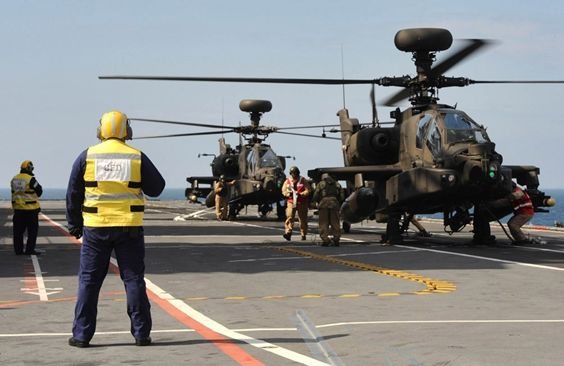As Army aviation’s flight path continues through the drawdown and budgetary constraints, it will swap some helicopters around and defund others, said Maj. Gen. Kevin W. Mangum.
In so doing, Army aviation will get the right mix it needs to be ready and relevant, he said. The general spoke during the Association of the United States Army Aviation Symposium, Tuesday, in Arlington, Va.
Repeating words spoken in March 2013 by Chief of Staff of the Army Gen. Ray Odierno, the commanding general for the U.S. Army Aviation Center of Excellence told conference attendees that the Army must strike the right balance with aviation capability.
“We can’t afford to have too little aviation, but we darned sure cannot afford to have too much,” Mangum said.
It was March of last year when the Army first started feeling the effects of sequestration and drawdown, Mangum said. “Ever since then, we’ve been trying to strike a balance,” he said.
The balancing efforts actually go back further to 2010, when an analysis of alternatives study was done on how best to fulfill the requirement for an armed aerial scout helicopter, Mangum said.
The outcome of that study showed that the optimal choice would be a mix of AH-64E Apache helicopters, teamed with unmanned systems.
At the time, “we didn’t have enough money to fund all the AH-64s necessary” to do that, he continued.
“But now with a smaller force, we have the opportunity to get to that mix and repackage the 698 AH-64s, teaming them up with the Shadow and Grey Eagle” unmanned aerial systems “to meet about 80 percent of that armed aerial scout requirement,” he said.
The money to do that and upgrade the Apaches from D to E models would come from divesting the fleet of OH-58 Kiowas, Mangum said.
Modernizing the Kiowas would have cost more than $10 billion, and that money was not there, he said. But modernizing the Apaches — despite their higher costs in fuel — would save money in the long run.
“You can imagine the love notes I got over that” decision, he said.
But by getting rid of the Kiowas, he said the Army also saved money and manpower by eliminating about 15 military occupational specialties that went with the aircraft, along with their programs of instruction. It also lessened aviation’s reliance on contractors.
“We reduced the logistics tail,” he said.
HELICOPTER SWAPPING
Besides defunding the Kiowa, Army aviation will need to swap helicopters around between the active and reserve components.
The idea is to pull AH-64s out of the RC and give them to the AC, he said, while pulling UH-60 Black Hawk helicopters out of the AC and giving them to the RC.
The Black Hawks will provide the lift and medevac capabilities the Guard needs for its Title 32 missions, as well as better supporting homeland defense.
The Apaches, he said, “don’t do much for a governor during a natural disaster.”
The decision for the swaps in the components and the decision to divest the Kiowas involved not just decisions out of Fort Rucker, but from the entire Army as well as the Guard and Reserve, he said.
Besides swapping helicopters, the drawdown would also have ramifications for the total number of units — meaning fewer.
Just a few years ago, the Army was planning for 15 combat aviation brigades, or CABs, he said. The 13th is now being built at Fort Carson, Colo. However, it’s likely there could soon be fewer than 13, with a worst-case scenario of 10.
No decision has been reached on that, he said, so “the chief told us to do a five-year plan.”
When the order to execute is given, Mangum said “we’ll provide a glide slope with decision points along the way” so leaders can take the “off-ramp” at any time should they wish to go lower.
Another goal of Army aviation, Mangum said, is to become more modular, meaning having the flexibility and expeditionary capability as the Army draws down from Afghanistan and goes into regionally aligned missions around the world. This will involve restructuring within the CABs and making each one more uniform or interchangeable with the other.
CHANGES AT RUCKER
The budgetary turbulence has also impacted Fort Rucker.
Last year, the installation took a $250 million cut, which translated to a loss of about 30 percent of its training flight hours.
As a result, only 899 students are in initial-level rotary training compared to about 1,250 a year ago. “That’s a pretty significant reduction,” Mangum said.
Rucker is doing some helicopter swapping of its own. It’s replacing its legacy TH-67 Creek helicopter trainers with UH-72 Lakotas, some of which it’s getting from the Guard, he said.
“The good thing about UH-72s is they’re bought and paid for,” he said.
Also in the works for Rucker and other locations is to rely more on simulators as flying hours are reduced. The problem, he said, is “there’s no pocket change in the near-term to invest in those systems.”
And there’s very little pocket change for other helicopter upgrades around the Army, he said.
“I tell youngsters who are in the Basic Officer Leader Course that when some of you retire from the Army in 20, we still will not have finished fielding the UH-60M and AH-64E,” he said. “That’s how far we’ve pushed these programs.
“People don’t like that word lean,” he continued. “I don’t either, but there won’t be any fat in this Army,” he said, drawing laughs from several hundred aviators and industry reps in attendance.
He concluded: “As the chief said, regardless of the size of our Army, we’re going to be the best Army in the world. I say the same applies to our premier aviation force which is relentlessly focused on commanders and Soldiers on the ground, who expect us to be there when [they need us.]”










